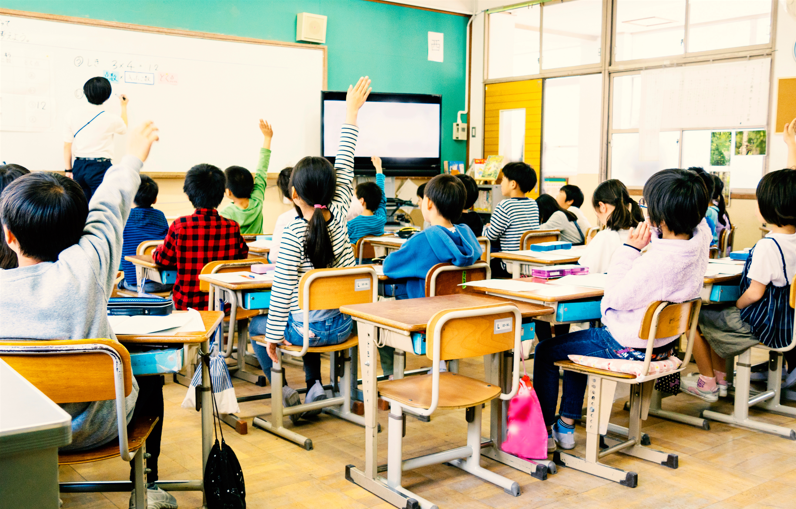Part A Introduction & Ice break

Part A_1 Introduction & Ice break
Let’s introduce ourselves to each other.
My name is ________. What is your name?
Part A_2 Introduction & Ice break
I am ________. Nice to meet you.


Part A_3 Introduction & Ice break
Nice to meet you too, ________. How are you today?
Part A_4 Introduction & Ice break
| Answer: |


Part A_5 Introduction & Ice break
I see. Let’s begin our lesson!
Part B Picture Description
Describe the pictures.

Part B_1 Picture Description
Please look at the picture. Then, give 5 things that you see in the picture.
(If your student is having a hard time to answer, please point at each item in the picture and ask your student what each item is.)

Part B_2 Picture Description
| 1. | |
| 2. | |
| 3. | |
| 4. | |
| 5. |


Part B_3 Picture Description
Next, give 3 things that you see in the picture. Then, answer the question about it.
(If your student is having a hard time to answer, please point at each item in the picture and ask your student what each item is.)

Part B_4 Picture Description
| 1. | |
| 2. | |
| 3. |


Part B_5 Picture Description
| Do you think the study environment in the picture is good for education? Why do you think so? |
Part B_6 Picture Description
| Answer: |


Part B_7 Picture Description
Now, let’s review your answers.
(Please review your student’s answers by sending the correct answers.)
Part B_8 Picture Description

Part C Vocabulary
Learn the vocabulary words related to the topic.

Part C_1 Vocabulary
We’ll read aloud the words. Please repeat after me.
Part C_2 Vocabulary
 |
diverse 多様な |
 |
unemployment 失業、失業率 |
 |
inequality 不平等 |
 |
responsibility 責任 |
|
To conclude 結論として |


Part C_3 Vocabulary
Please choose a word to complete each sentence. Then, read aloud the sentences.
Part C_4 Vocabulary
diverse
unemployment
inequality
responsibility
conclude
| 1. | Protecting the environment is our ___________. |
| 2. | One of the causes of the youth ___________ rate is the gender inequalities. |
| 3. | Gender ___________ is a major problem around the world. |
| 4. | To ___________, we must take action now. |
| 5. | We work with people from ___________ cultures. |


Part C_5 Vocabulary
Great! Now, let’s review your answers.
(Please review your student’s answers by sending the correct answers in complete sentences. After that, ask your student to read aloud his or her corrected answers.)
Part C_6 Vocabulary

Part D Passage Reading
Read the passage and check your pronunciation. Make sure you understand the content.

Part D_1 Passage Reading
Please read the passage aloud.
Part D_2 Passage Reading
Working together

People discuss youth at the United Nations. But the strange thing is, there are almost no youth in the room. It is good to talk about young people, but it is a lot better to talk with them. Something became clear since young people took part in writing this speech. We should work together as a team despite our differences and diverse cultures. Diversity is our strength, not a weakness.
First, there is deep concern over the rapidly increasing rates of youth unemployment. Second, the weakest and most marginalized people should be included in new frameworks. For example, all girls must have access to quality healthcare and education. Thirdly, we want a society where our leaders have integrity and responsibility.
We have a chance of experiencing long-term success. But only if we are successful in bringing many generations together right now. To conclude, you and your activities affect all young people and families worldwide.
*diversity 多様性
*marginalized people 疎外された人々
*framework 枠組み
*integrity 誠実さ
*marginalized people 疎外された人々
*framework 枠組み
*integrity 誠実さ


Part D_3 Passage Reading
Great! Now, let’s review some words and sentences in part D_2.)
(Please send the corrected pronunciation to your student.)
Part D_4 Passage Reading

Part E Comprehension Questions
Answer the following questions based on the passage.

Part E_1 Comprehension Questions
Now, please answer the questions based on the passage.

Part E_2 Comprehension Questions
| 1. | What is strange about the UN conference? |
Part E_3 Comprehension Questions
| Answer: |


Part E_4 Comprehension Questions
| 2. | What became clear when young people took part in writing the speech? |
Part E_5 Comprehension Questions
| Answer: |


Part E_6 Comprehension Questions
| 3. | Did the speaker say that the weakest and most marginalized people should be included in this meeting? |
Part E_7 Comprehension Questions
| Answer: |


Part E_8 Comprehension Questions
Now, let’s review your answers.
(Please review your student’s answers by sending the correct answers.)
Part E_9 Comprehension Questions

Part F Answer questions
Answer the following questions by filling out the blanks.

Part F_1 Answer questions
Now, please answer the following questions about yourself.

Part F_2 Answer questions
| 1. | Do you think youth, including you, should know more about social problems and lead the world? |
Part F_3 Answer questions
| Answer: |


Part F_4 Answer questions
| 2. | Do you take any actions for the environment or any of the SDGs? What is it? Anything you can think of. Example: bring your own reusable bag, turn off the lights frequently, etc. |
a reusable bag マイバッグ
turn off the lights frequently 電気をこまめに消す
turn off the lights frequently 電気をこまめに消す
Part F_5 Answer questions
| Answer: |


Part F_6 Answer questions
| 3. | The SDGs have 17 goals. Which one are you most interested in? Tell me the reason as well. |
– No Poverty
– Zero Hunger
– Good Health and Well-Being
– Quality Education
– Gender Equality
– Clean Water and Sanitation
– Affordable and Clean Energy
– Decent Work and Economic Growth
– Industry, Innovation and Infrastructure
– Reduced Inequalities
– Sustainable Cities and Communities
– Responsible Consumption and Production
– Climate Action
– Life Below Water
– Life on Land
– Peace, Justice and Strong Institutions
– Partnerships for the Goals
– Zero Hunger
– Good Health and Well-Being
– Quality Education
– Gender Equality
– Clean Water and Sanitation
– Affordable and Clean Energy
– Decent Work and Economic Growth
– Industry, Innovation and Infrastructure
– Reduced Inequalities
– Sustainable Cities and Communities
– Responsible Consumption and Production
– Climate Action
– Life Below Water
– Life on Land
– Peace, Justice and Strong Institutions
– Partnerships for the Goals
Part F_7 Answer questions
| Answer: |


Part F_8 Answer questions
Now, let’s review your answers.
(Please review your student’s answers by sending the correct answers in complete sentences. After that, ask your student to read aloud his or her corrected answers.)
Part F_9 Answer questions

Part G Presentation
Make a presentation about the theme.

Part G_1 Presentation
Now, you will give a presentation. You can use the answer you just provided. You have 3 minutes to prepare.
Part G_2 Presentation
(Prepare for 3 minutes.)


Part G_3 Presentation
Then, start your presentation.
Part G_4 Presentation
(Please start your presentation now.)
My interesting topic about the SDGs is …


Part G_7 Presentation
That was awesome! You did a very good job in the presentation.
Part H Questions
Answer questions about the presentation.

Part H_1 Questions
Thank you for your presentation. You did a very good job.
Now, I will ask you some questions about your presentation.
Now, I will ask you some questions about your presentation.
(Please ask the three questions below about the student’s presentation.)
| 1. | What are the new things you learned through thinking about the theme? Why do you think so? |
| 2. | What do you think we can do related to the theme? How we can do it? |
| 3. | Is there anything you do related to the theme? If yes, what do you do? If no, why not? |
Part H_2 Questions
| Answer: |


Part H_3 Questions
Good job! Thank you for sharing your opinion!
Part I Role play
Talk about the following situation.

Part I_1 Role play
Let’s do a role play with the given situation. You should mention the items below during the conversation.
Part I_2 Role play
| Situation: |
You are talking with your friends about extreme weather. Discuss what to prepare for extreme weather.
(Your tutor will pretend to be your friend.)
|
| Items to mention: |
– extreme weather in Japan – how extreme weather affects our daily lives – what to prepare for extreme weather |
extreme weather 異常気象

Part J Feedback

Part J_1 Feedback
You did a wonderful job. Now, I will give you some feedback.

Part J_2 Feedback
(Please give feedback on how the student performed in the lesson.)
| Vocabulary | Intonation | Fluency | |
|---|---|---|---|
 GOOD GOOD |
Used appropriate expressions learned in class. | Was able to pronounce most of the words clearly and correctly. | Was able to speak fluently. |
 FAIR |
Used appropriate expressions learned in class and made a few errors in word choice. | Mispronounced a few words. | The conversation sometimes stops. |
 POOR |
Used only a few words and expressions. | Mispronounced most of the words. | The student frequently stops the conversation, making it difficult to comprehend the content. |
Part K Free talk

Part K_1 Free talk
Let’s do a free talk.
(Have a conversation until the lesson ends. DO NOT end the class early.)

Part K_2 Free talk
| 1. | Do you want to travel abroad? |
| 2. | What do you think learning English means for you? |
| 3. | What do you think Japanese originality is? |
Part K_3 Free talk
| Answer: |

